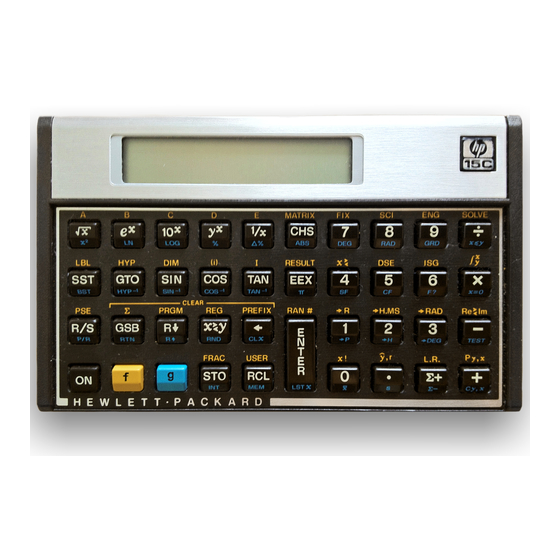Table of Contents
Advertisement
Quick Links
HP-15C Quick Reference
Memory
Approx. 462 bytes of memory corresponding to 66 registers, 7 bytes each,
4-level stack, Last-X, index register I.
Nonvolatile memory, mostly merged program commands (1 byte per
instruction)
Pr Error
Displayed when the contents of the nonvolatile (continuous memory) has
been lost
Number
Turn off, press & hold ON, press ".", release ON, release "."
separator
This toggles between using a dot or comma for the decimal separator.
Global
Turn off, press & hold ON, press "-", release ON, release "-"
reset
This clears all permanent memory!
MEM
Displays memory assignment in the form "RR UU pp – n" with:
RR: Number of highest storage register. At least 1 which means that R0, R1
and the index register I are always present. Register 0-19 correspond to
0-9 & .0-.9 and can be accessed directly by STO/RCL. Higher registers
can be reached thru indirect addressing only.
UU: Number of uncommitted registers. Use DIM to commit them to storage
registers. Uncommitted registers are automatically converted to
program space when needed.
pp: Number of registers containing program instructions. One register
consists of 7 bytes and can hold 7 program steps (except for a few
instructions that occupy two bytes).
n:
Number of bytes left before next uncommitted register is converted to
program space.
In total there are 66 registers corresponding to 462 bytes.
The initial setup is "19 46 0-0": 20 storage registers (0-19), 46 uncommitted
registers, corresponding to approx. 322 program steps.
DIM (i)
Use this command to select the number of registers committed to storage.
The argument must be passed in X. It specifies the highest storage register
number.
Registers containing program instructions cannot be converted to storage
registers!
X must be at least 1 so there will always be R0 and R1 available.
The maximum is 65
FIX 0-9
Select fix-point format
SCI 0-9
Select scientific format with exponent
ENG 0-9
Select engineering format with exponent always being a multiple of 3
HP-15C
©
A. Thimet
Memory & Display
1
Advertisement
Table of Contents

Summary of Contents for HP 15C
- Page 1 HP-15C HP-15C Quick Reference © A. Thimet Memory & Display Memory Approx. 462 bytes of memory corresponding to 66 registers, 7 bytes each, 4-level stack, Last-X, index register I. Nonvolatile memory, mostly merged program commands (1 byte per instruction) Pr Error...
- Page 2 HP-15C Clearing Data ← RUN mode: Deletes either the last digit during number entry or the entire X-register in case number entry has been terminated. PRGM mode: Delete the currently displayed program step CLEAR ∑ Clear stack and summation registers 0-5...
-
Page 3: Functions (Selection)
HP-15C Functions (Selection) RAN# Create random number 0 ≤ X < 1 STO f RAN# Store X as the new random number seed → P Convert (X=x,Y=x) from orthogonal to polar coordinates (X=r,Y=θ) See label on the back of the calculator →... - Page 4 HP-15C x Calculate ∑x & ∑y mean value and place result in X & Y. Requires n>0 Calculate ∑x & ∑y standard deviation and place result in X & Y. sx = SQRT[ {n∑x – (∑x) } / {n(n-1)} ], accordingly for sy.
- Page 5 HP-15C LBL 0-9, .0-.9, A-E Insert label GT0 0-9, .0-.9, A-E RUN: Set program counter to the specified label PRGM: Insert a GTO instruction GSB 0-9, .0-.9, A-E RUN: Execute the program starting at the given label PRGM: Insert a GSB instruction. A maximum of seven subroutine...
-
Page 6: Complex Numbers
HP-15C Complex Numbers Memory In complex mode a complex stack including Last-X register exists. The needed five registers are allocated from the uncommitted memory space, see MEM. f I -or- Automatically turns on the complex mode. Indicated by "C" in the Re↔Im... -
Page 7: Matrix Operations
HP-15C Matrix Operations Memory A total of 64 matrix elements can be used in a total of 5 matrices named A-E. Different matrices can have different size; sometimes the result of a matrix operation can overwrite the input matrix. The registers for the matrix elements are allocated from the uncommitted registers space, see MEM. - Page 8 HP-15C STO g A-E, (i) Same as above but the stack's Y register contains the row number and X the column number, starting from 1. The value must be present in Z. Both X & Y will be popped from the stack so that the value ends up in...
- Page 9 Refer to pg. 160ff of the Owner's Manual. Complex matrix operations are not supported directly. However, these operations can be rewritten so that they can be solved using only real matrices. The HP-15C provides a number of functions to simplify the conversions between complex and corresponding real...
-
Page 10: Root Finding (Solver)
HP-15C Always returns false if X contains a matrix descriptor TEST 0 (X≠0) Always returns true if X contains a matrix descriptor TEST 5 (X=Y) Returns true if X and Y contain the same matrix descriptor. This does not compare any matrix elements! TEST 6 (X≠Y) -
Page 11: Numerical Integration
"interesting". Ie. exp(-x²) around x=0 – if this function is integrated from 1E-50 to 1E+50 then the result will be 0 because the algorithm missed the interesting part around 0 • Fore more details see HP-15C Owner's Handbook, Appendix E, pg.240ff and The HP-15C Advanced Functions Handbook...













